Norman, Oklahoma, Hgh State Clinic, Hgh Injections, Hrt Doctors
Norman, Oklahoma Blood Testing Facilities
 Represents a LabCorp blood testing facility
Represents a LabCorp blood testing facility Represents a Quest Diagnostics blood testing facility
Represents a Quest Diagnostics blood testing facility
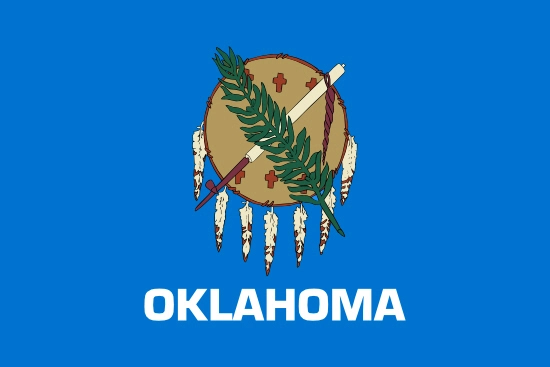
Nearby Labcorp Blood Testing facilities:
- Labcorp Center Distance: 2 m, 1010 24Th Ave Nw Ste 130, Norman, Cleveland County, OK, 73071
- Labcorp Center Distance: 12 m, 8125 S Walker Ste C, Oklahoma City, Oklahoma County, OK, 73139
- Labcorp Center Distance: 16 m, 1201 S Douglas Blvd Ste A, Midwest City, Oklahoma County, OK, 73112
- Labcorp Center Distance: 18 m, 1111 N Lee Ste 235, Oklahoma City, Oklahoma County, OK, 73103
- Labcorp Center Distance: 22 m, 5401 N Portland 110, Oklahoma City, Oklahoma County, OK, 73112
- Labcorp Center Distance: 28 m, 3705 W Memorial Rd Ste 1406, Oklahoma City, Oklahoma County, OK, 73134
Nearby Quest Blood Testing facilities:
- Quest Center Distance: 0 m, 900 N Porter Ave Ste 109, Norman, Cleveland County, OK, 73071-6426
- Quest Center Distance: 4 m, 3201 W Tecumseh Rd, Norman, Cleveland County, OK, 73072-1819
- Quest Center Distance: 12 m, 8100 S Walker Ave, Oklahoma City, Oklahoma County, OK, 73139-9402
- Quest Center Distance: 15 m, 4221 South Western Avenue, Oklahoma City, Oklahoma County, OK, 73109-3447
- Quest Center Distance: 16 m, 9060 Harmony Drive, Midwest City, Oklahoma County, OK, 73130-6253
- Quest Center Distance: 19 m, 106 S Castlerock Ln, Mustang, Canadian County, OK, 73064-4586
- Quest Center Distance: 22 m, 3366 Nw Expressway, Oklahoma City, Oklahoma County, OK, 73112-4444
- Quest Center Distance: 24 m, 9600 North Broadway Extension, Oklahoma City, Oklahoma County, OK, 73114-7408
- Quest Center Distance: 25 m, 1607 Professional Cir, Yukon, Canadian County, OK, 73099-6314
- Quest Center Distance: 27 m, 3824 S Boulevard St, Edmond, Oklahoma County, OK, 73013-5478
- Quest Center Distance: 28 m, 13901 Mcauley Blvd, Oklahoma City, Oklahoma County, OK, 73134-8700
- Quest Center Distance: 29 m, 4833 Integris Parkway, Edmond, Oklahoma County, OK, 73034-8864
- Quest Center Distance: 30 m, 3700 N Kickapoo Ave, Shawnee, Pottawatomie County, OK, 74804-1707
- Quest Center Distance: 54 m, 701 Better Now Plaza, Ada, Other, OK, 74820-2643
- Quest Center Distance: 56 m, 1509 Brookwood Ave, Duncan, Stephens County, OK, 73533-1315
- Quest Center Distance: 65 m, 819 S Pine St, Stillwater, Payne County, OK, 74074-4350
- Quest Center Distance: 70 m, 4411 W Gore Blvd, Lawton, Comanche County, OK, 73505-5977
- Quest Center Distance: 71 m, 1401 Sw Parkridge Blvd Ste C, Lawton, Comanche County, OK, 73505-7575
- Quest Center Distance: 73 m, 107 N Commerce St, Ardmore, Carter County, OK, 73401-3904
- Quest Center Distance: 84 m, 915 East Owen K Garriott, Enid, Garfield County, OK, 73701-5952
- Quest Center Distance: 88 m, 812 W Gary Blvd, Clinton, Custer County, OK, 73601-2720
- Quest Center Distance: 97 m, 1500 N Strong Blvd, Mcalester, Pittsburg County, OK, 74501-3842
- Quest Center Distance: 99 m, 607 E Main St, Jenks, Tulsa County, OK, 74037-4138
Oklahoma Hormone Replacement Therapy Services
If you are like most aging men and women in the United States, you are incredibly concerned with preserving your health. Have you ever considered Hormone Replacement Therapy? The Conscious Evolution Institute provides quality HRT services to residents all over the state of Oklahoma.
So many Americans resign themselves to the aging process, without realizing that many of the worst symptoms related to aging can be mitigated or even in some cases reversed by effective lifestyle choices and medical intervention. Our licensed and certified medical professionals can analyze your hormone profile and help you discover if you qualify for Hormone Balance and Restoration Treatments.
Oklahoma Testosterone Deficiency Treatments
As the body of clinical research grows, it becomes apparent that Age-Related Low-T is a more common problem than once believed. The most prominent symptoms of Testosterone Deficiency are related to sexual health, but Testosterone is intricately involved in preserving a number of aspects of male health.
If you are suffering from significant fatigue, loss of strength, increased body mass, anxiety, hypertension, or high cholesterol, you may be suffering from Testosterone Deficiency. We can provide medical treatments guaranteed to restore your Testosterone Balance, enhance your sex life, and improve your overall health and well-being.
Oklahoma HGH Replacement Therapy
Most men (and women) are becoming more aware of the pitfalls of Testosterone Deficiency, but did you know that Human Growth Hormone Deficiency can create just as many problems for your health and your life? Age-Related HGH Deficiency (frequently referred to as Somatopause) is a medical condition in which the body does not produce sufficient Human Growth Hormone to meet its needs.
Human Growth Hormone is intricately involved in cellular metabolism, and sustains healthy processes throughout the body. If you aren't producing enough, then your health can deteriorate as a direct result. If you a man or woman over the age of thirty, and you are suffering from symptoms such as weight gain, loss of muscle mass, depression, listlessness, increased susceptibility to illness, trouble sleeping, or slow healing, you may be a prime candidate for HGH Injection Therapy.
We also offer an alternative form of treatment known as Sermorelin Acetate, which also has the capability to restore flagging HGH Levels. HGH supplements your natural Human Growth Hormone Production, but Sermorelin shots encourage your body to meet its own needs! Just ask our doctors which treatment is best for you!
Oklahoma HCG Weight Loss Treatments
The Conscious Evolution Institute also offers highly effective weight loss treatments, including HCG Therapy. If you are overweight or clinically obese, and have tried other diets and treatments with little success, consider trying HCG.
HCG Injections are an amazing medical treatment which helps you lose weight by actually making you less hungry! Our HCG Diet plan combines medical therapy with Caloric Restriction in order to help you lose five pound per week or more!
Major Cities in Oklahoma
Oklahoma City
Oklahoma City is the largest city in Oklahoma, as well as the capital of the state. The city is home to one professional sports team: The Oklahoma City Thunder. The city has a number of tourist destinations, including the Oklahoma City Museum of Art, the National Cowboy and Western Heritage Museum, and the American Banjo Museum.
Two of the strongest markets in Oklahoma City are agriculture and natural resources. Oklahoma City is known for being one of the largest centers for livestock sales in the entire world, and petroleum, natural gas, and oil are overwhelmingly powerful economic factors.
Tulsa
Tulsa is the second most populated city in Oklahoma, and is the most densely populated city in the state. Like Oklahoma City, Tulsa is a very important city for oil distribution and manufacturing, and was coined the Oil Capital of the World in the 20th century.
Tulsa is home to two major universities, Oral Roberts University and Tulsa, both of which have Division 1 Athletic programs. Tulsa resides in an area of the state referred to as Green Country, because of the abundant forests in the northeastern region of the state. Tulsa has a number of quality museums, including the Sherwin Miller Museum of Jewish Art, the Gilcrease Museum, and the Philbrook Museum.
Norman
Norman, Oklahoma is a suburb of Oklahoma City, located about twenty miles to the south. Norman is most well known for being the home of the University of Oklahoma. Norman is the third most populous city in the state. Because of the prominent and dangerous weather in Oklahoma, Norman was also chosen to be the home of the National Weather Center.
Because of Oklahoma's vast energy reserves, Norman also has a large presence in both geology and energy research, the home of both the Oklahoma Renewable Energy Council and the Oklahoma Geological Survey. Green Energy plays a role in the economy, and Bergey Windpower and SouthWest Nanotechnologies are both based in the city.
Broken Arrow
Broken Arrow is a suburb of Tulsa, Oklahoma, and is the fourth most populous city in the state. Broken Arrow got its name from the Native Americans that moved to the area from Alabama during the Trail of Tears. The city is notable for having the lowest crime rates of any major city in Oklahoma, and Broken Arrow is frequently listed as one of the best places to live in the country.
Broken Arrow has a complex economy with an emphasis on manufacturing. A few of the largest employers in the city are Windstream Communications, Blue Bell Creameries, and FlightSafety International (FSI).
Lawton
Lawton is located in southwestern Oklahoma, and is the fifth most populous city in the state. Lawton is located very close to a military installation known as Fort Sill Military Reservation, and this remains a stabilizing force on the economy. The military is the largest source of employment in the area, but other major employers include health care, higher education, and manufacturing. Lawton has a number of museums, including the Comanche National Museum and the Museum of the Great Plains.
All About Norman, Oklahoma Geographic Area
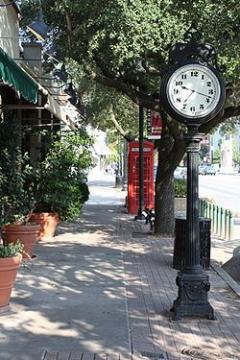
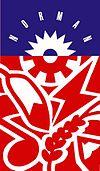
Norman ( /ËnnÉermÉon/) is a city in the state of Oklahoma that is located 20 miles (30 km) south of downtown Oklahoma City. It is part of the Oklahoma City metropolitan area. With a population of 110,925 as of the 2010 census, Norman is the third-largest city in Oklahoma and the 235th-largest city in the United States. The city serves as the county seat of Cleveland County.
/ËnnÉermÉon/) is a city in the state of Oklahoma that is located 20 miles (30 km) south of downtown Oklahoma City. It is part of the Oklahoma City metropolitan area. With a population of 110,925 as of the 2010 census, Norman is the third-largest city in Oklahoma and the 235th-largest city in the United States. The city serves as the county seat of Cleveland County.
Norman was settled during the Land Run of 1889, which opened the former Indian Territory and Unassigned Lands to American pioneer settlement. The city was named in honor of its first land surveyor, Abner Norman, and was formally incorporated on May 13, 1891. Today the city is known for its higher education and related research industries. Norman is home to the University of Oklahoma, the largest university in the state with approximately 30,000 students enrolled. The university is well known for its sporting events, with over 80,000 people routinely attending football games. The university is also home to several museums including the Fred Jones Jr. Museum of Art, which contains the largest collection of French Impressionist art ever given to an American university.
The National Weather Center, located in Norman, houses a unique collection of university, state, and federal organizations that work together to improve the understanding of events related to the Earth's atmosphere. Norman lies within Tornado Alley, a geographic region where tornadic activity is predominant. The Oklahoma City metropolitan area, including Norman, is the most tornado-prone area in the United States. In addition to this, the SPC or Storm Prediction Center, a branch of the National Oceanic and Atmospheric Administration, is located in Norman due to its location. The facility is used for forecasting severe storm and tornado outbreaks in addition to housing various experimental weather radars.
In 2008, CNN/Money Magazine ranked Norman as the sixth best small city within the United States to live in, the highest ranking of any city in Oklahoma.
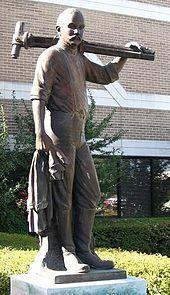
The Oklahoma region became part of the United States with the Louisiana Purchase in 1803. Prior to the American Civil War the United States government began relocating the Five Civilized Tribes - the five Native American tribes that the United States officially recognized via treaty - to Oklahoma. Treaties of 1832 and 1833 assigned the area known today as Norman to the Creek Nation.
Following the Civil War, the Creeks were accused of aiding the Confederate States of America and as a result they ceded the region back to the United States in 1866. Shortly after this the Arbuckle Trail, a feeder route to the Chisholm Trail, was developed to hasten the transfer of cattle from Texas to the railroads in Kansas. A federal survey of the empty lands along the Arbuckle Trail was undertaken in the early 1870s, headed by 23-year-old Abner Norman. Norman aos work crew set up camp at what is today the corner of Classen and Lindsey streets; it was there that the men, perhaps jokingly, carved a sign on an elm tree that read "Norman aos Camp," in honor of their young surveyor. In 1887, the Atchison, Topeka and Santa Fe Railway began service to the area, which was later opened to settlement as part of the Land Run of April 1889; early settlers decided to keep the name "Norman."
On April 22, 1889, the Land Run saw the founding of Norman with at least 150 residents spending the night in makeshift campsites; by the next morning a downtown was already being constructed. Almost immediately two prominent Norman businessmen, former Purcell railroad freight agent Delbert Larsh and railroad station chief cashier Thomas Waggoner, began lobbying for the territorial government to locate its first university in Norman. The two were interested in growing the city and had reasoned that rather than trying to influence legislatures to locate the heavily contested territory capitol in Norman that it made sense to attempt to secure the state's first university instead (a move that would be far less controversial). On December 19, 1890, Larsh and Waggoner were successful with the passage of Council Bill 114, establishing the University of Oklahoma in Norman approximately 18 years before Oklahoma statehood.

The city of Norman was formally incorporated on May 13, 1891. The city has continued to grow throughout the decades. By 1902 the downtown district contained two banks, two hotels, and a flour mill, and other businesses; by 1913 there were over 3,700 residents living in Norman when the Oklahoma Railway Company decided to extend its interurban streetcar running from Oklahoma City to Moore into Norman, spurring additional population growth. The rail lines eventually transitioned to freight during the 1940s as the United States Numbered Highway system developed. The city population reached 11,429 in 1940.
In 1941, the University of Oklahoma and Norman city officials established Max Westheimer Field, a university airstrip, and then leased it to the US Navy as a Naval Flight Training Center in 1942. The training center was used for training combat pilots during World War II. A second training center, known as Naval Air Technical Training Center, and a naval hospital were later established to the south. In the years following World War II the airstrip was transferred back to the university's control. Today the airstrip is called the University of Oklahoma Westheimer Airport. Following the war the remaining military presence and post-war veterans who came to Norman to get an education again grew the city's population, which was 27,006 by 1950. The Navy again utilized the bases in a lesser capacity from 1952 to 1959 in support of the Korean War effort.
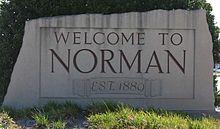
With the completion of Interstate 35 in June 1959, Norman found its role as a bedroom community to Oklahoma City increasing rapidly; in 1960 Norman's population was 33,412 but by the end of the decade had grown to 52,117. Throughout the 1960s Norman's land mass increased by 174 square miles (450 km2) by annexing surrounding areas. The city's growth trends have continued early in the 21st century, with the population reaching 95,694 in 2000 and 110,925 in 2010.
A council-manager government has been in place in Norman since the adoption of its city charter on June 28, 1919. A councilor from each of the city's eight council wards is elected to office every two years, each serving a term of two years. Councilors are elected from their own respective wards based on a plurality voting system; a councilor from each ward serves on the Norman City Council. A mayor is elected by the entire voting population of Norman and serves as an at-large councilor; the mayor serves for a term of three years. As a whole, the council acts as the legislative body of city government; it aims to pass laws, approve the city budget, and manage efficiency in the government. The City Council appoints a professional City Manager who is responsible for the day-to-day administrative activities of the city. The City of Norman has approximately 650 employees working in eleven departments and 31 boards and commissions that help oversee and implement the policies and services of the city. The City Council meets bi-weekly in City Hall located at 201 W. Gray Street in downtown Norman; various boards and commissions meet in accordance with their own schedules. The present mayor of Norman is Cindy Rosenthal (elected in 2007), and the city manager is Steve Lewis (appointed in 2007). In accordance with the charter of the city of Norman, all city elected positions are nonpartisan.
Municipal and state laws are enforced by the Norman Police Department. In 2010, Norman's crime index was 33% less than the national average. There were two murders, 47 rapes, 36 robberies, 53 assaults, and 811 burglaries in 2010.
In accordance with Sister Cities International, an organization that began under President Dwight Eisenhower in 1956, Norman has been given three international sister cities in an attempt to foster cross-cultural understanding:
Norman is located at 35 °13 a²N 97 °25 a²W / 35.2217 °N 97.4183 °W / 35.2217; -97.4183 (35.2216, -97.4182) As of 2010, the city has a total area of 189.4 square miles (491 km2), of which 178.8 square miles (463 km2) is land and 10.6 square miles (27 km2) is water.
Norman and the surrounding areas are mostly flat with an elevation near mean sea level. The terrain in the western section of Norman is prairie while the eastern section, including the area surrounding Lake Thunderbird, consists of some 6,000 acres (24 km2) of lakes and Cross Timbers forest. The lowest point within city limits is approximately 970 feet (296 m) above sea level (located at 35.20388N, 97.17735W). The highest point is approximately 1,245 feet (379 m) above sea level (located at 35.21266N, 97.39000W).
Norman falls within a temperate, humid subtropical climate region that is identified as "cfa" class on the Koppen climate classification. On average Norman receives about 38 inches (970 mm) of precipitation per year; May and June are the wettest months. Temperatures average 61 °F (16 °C) for the year. Average daytime highs range from 50 °F (10 °C) in January to nearly 93 °F (34 °C) in August; average lows range from 28 °F ( na2 °C) in January to 71 °F (22 °C) in July and August. Summers can be extremely hot, as was evident in 2009 when temperatures climbed above 100 °F (38 °C) for more than a month. Consistent winds, averaging near 10 mph (16 km/h) and usually from the south to southeast, help to temper hotter weather during the summer and intensify cold periods during the winter.
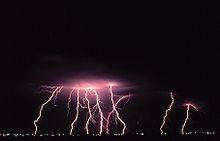
Norman averages a growing season of 209 days, but plants that can withstand short periods of colder temperatures may have an additional three to six weeks. Winter months tend to be cloudier than summer months, with the percentage of possible sunshine ranging from an average of about 55% in winter to nearly 80% in summer.
Norman lies within Tornado Alley, the region of the United States where tornadic activity is most predominant. The city has a tornado season lasting from March through June with over 80% of all reported tornadoes occurring during these months. The Oklahoma City metropolitan area, including Norman, is the most tornado-prone area in the United States. As recently as May 10, 2010, a tornado outbreak occurred in southeastern Norman that resulted in the loss of multiple homes and businesses. Again on Friday April 13, 2012 Norman was struck by a weak tornado.
As of the census of 2010, there were 110,925 people, 44,661 households, and 24,913 families residing within the city. The population density was 616 people per square mile (208.7/km ²). The racial makeup of the city was 84.7% White, 4.3% African American, 4.7% Native American, 3.8% Asian, 0.1% Pacific Islander, 1.9% from other races, and 5.5% from two or more races. Hispanic or Latino of any race were 6.4% of the population.
Of the 44,661 households, 25.0% had children under the age of 18, 41.5% were married couples living together, 10.1% had a female householder with no husband present, and 44.2% were non-families. Individuals living alone made up 30.7% of all households; 7.3% had someone living alone who was 65 years of age or older. The average household size was 2.33 and the average family size was 2.94.
The age distribution was 5.8% under the age of 5, 5.7% from 5 to 9, 5.2% from 10 to 14, 8.9% from 15 to 19, 16.0% from 20 to 24, 9.0% from 25 to 29, 6.6% from 30 to 34, 5.6% from 35 to 39, 5.3% from 40 to 44, 5.9% from 45 to 49, 5.9% from 50 to 54, 5.4% from 55 to 59, 4.6% from 60 to 64, 3.2% from 65 to 69, 2.3% from 70 to 74, 1.8% from 75 to 79, 1.4% from 80 to 84, and 1.3% over 85 years of age. The median age was 29.6 years. Males made up 49.7% of the population while females made up 50.3%.
The median household income in the city was $44,396, and the median income for a family was $62,826. Males had a median income of $41,859 versus $35,777 for females. The per capita income for the city was $24,586. About 11.8% of families and 19.2% of the population were below the poverty line, including 18.9% of those under age 18 and 8.9% of those age 65 or over.
Although religious information is not collected by the US census, according to a 2000 survey by Dale E. Jones of the Association of Statisticians of American Religious Bodies, 50.2% of the population in Norman is affiliated with a religious institution. Of those 43.6% were Southern Baptist, 15.0% Catholic Church, 13.0% United Methodist, 3.3% Assembly of God, 2.8% Churches of Christ, 2.1% Mormon, 2.1% Christian Churches and Churches of Christ, 1.9% Disciples of Christ, 1.7% Presbyterian Church, and 14.6% other Christian denominations or religions.

The University of Oklahoma employs over 10,700 personnel across three campuses, making it a significant driver of Norman aos economy. The campus is a center for scientific and technological research, having contributed over $277 million to such programs in 2009.
Norman is also home of the National Weather Center, a cooperative research effort between the University of Oklahoma and the National Oceanic and Atmospheric Administration that houses a number of weather- and climate-related organizations; the city is also the proposed location of a future National Weather Museum. As a result of this on-going academic and public weather research, several private meteorological businesses are present in the city, including Weathernews Americas, Inc., Vieux and Associates, Inc., Weather Decision Technologies, WeatherBank, Inc., and Computational Geosciences, Inc.
In addition to weather, Norman is also a center for other scientific ventures both public and private. The Oklahoma Geological Survey, which conducts geological research, and the Oklahoma Renewable Energy Council, which is a public-private alliance that is attempting to foster renewable energy applications, both make the city their home. SouthWest NanoTechnologies is a producer of single-walled carbon nanotubes, and Bergey Windpower is a leading supplier of small wind turbines.
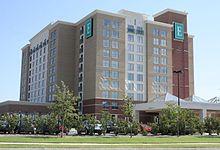
Other major employers in the city include Norman Regional Health System, Norman Public Schools, Johnson Controls, Griffin Memorial Hospital, Hitachi, Astellas Pharma Technologies, Albon Engineering, Xyant Technology, MSCI, Office Max National Sales Center, SITEL, the United States Postal Service National Center for Employee Development, Sysco Corporation, and AT&T.
University North Park, a lifestyle center with planned development on over 12 million square feet (1.1 km2) of land, is located on 24th Ave NW along the I-35 corridor between Robinson Street and Tecumseh Road. Begun in 2006, the project will feature 2 miles (3.2 km) of parks, offices, and high-end retail once completed.
In 2010, Norman became the 17th city in the United States to adopt a council resolution giving it status as a Fair Trade Town. The resolution states that the city of Norman supports the purchasing of goods from the local community; when goods cannot be purchased locally the city will support buying from producers abroad who meet Fair Trade standards. These standards include supporting quality of life in developing countries and planning for environmental sustainability.
Norman has a wide variety of neighborhoods. Downtown Norman is an area of approximately 2 square miles (5 km2) surrounded by University Blvd., Symmes St., Porter Ave., and Daws St.; primary streets include Main St. and Gray Ave. The area consists of restaurants, art galleries, and other businesses; it is home to some of the oldest buildings in Oklahoma.
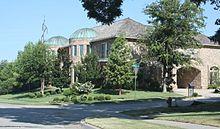
Hall Park is an area northeast of downtown Norman that was originally an independent township; in 2005 it was annexed into Norman, becoming one of its neighborhoods. The area is home to many upper middle-class suburban homes and is historically important in that it was advertised as the United States' first "all-electric town." President Ronald Reagan, then an executive with General Electric, attended Hall Park's grand opening ceremonies in 1962 where he was named the town's honorary first mayor.
The University of Oklahoma and the area surrounding it are home to many historically significant neighborhoods. The university itself has a unique Gothic-inspired architecture known as "Cherokee Gothic," so named by architect Frank Lloyd Wright. Churches and houses in the surrounding neighborhoods can be described as neo-Gothic or Queen Anne in style. Norman has two city-designated historic preservation districts in the area: the Miller Historic District, bounded by Symmes St., Classen Ave., and Miller Ave.; and the Chautauqua Historic District, bounded by Symmes St., Brooks St., Chautauqua Ave., and Lahoma Ave. Both of these residential neighborhoods contain houses designed from a mixture of architectural styles dating from 1903 to 1935, with the majority of the Miller neighborhood being of the Bungalow or American Craftsman style homes. Any external changes or repairs to homes in these areas must be approved by the Norman Historic Preservation Commission.
The area immediately north of the university is known as Campus Corner and contains a mixture of businesses, bars, and restaurants. The neighborhoods to the east of the campus are home to many students, both in residential housing and high-rise condos/apartments.
Norman enjoys many tree-lined landscapes, participating in the ReLeaf Norman and Tree City USA programs.
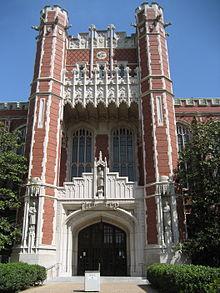
The University of Oklahoma is the largest university in the state of Oklahoma, with approximately 30,000 students enrolled. The university was founded in 1890, prior to Oklahoma statehood. The university includes both Norman and Oklahoma City campuses with the main campus located in Norman. In 2007, The Princeton Review named the University of Oklahoma one of its "Best Value" colleges. The school is ranked first per capita among public universities in enrollment of National Merit Scholars and has seen 28 Rhodes Scholars graduate since the program's inception in 1902. PC Magazine and the Princeton Review rated it one of the "20 Most Wired Colleges" in both 2006 and 2008, while the Carnegie Foundation classifies it as a research university with "high research activity."
The school is well known for its athletic programs, having won many awards including seven NCAA Division I National Football Championships.
The city of Norman is served by the Moore Norman Technology Center. The school was established in 1972 and has been awarded the Oklahoma Association of Technology Center aos Gold Star School Award on multiple occasions. The Franklin Road Campus consists of six buildings totaling 323,500 square feet (30,100 m2) of classroom, meeting, and office space. The school has a full-time staff of 207.
Norman Public Schools is a public school district serving metropolitan Norman; there are 15 elementary schools, four middle schools, and two high schools in the district. More than 17,000 students are enrolled in the district, making it one of the largest in the state.
Noble Public Schools is a school district that serves southeastern portions of Norman and the adjoining city of Noble, OK. It consists of two elementary schools, an intermediate school, a middle school, and a high school.
Little Axe Public Schools is a school district that serves the eastern rural area of Norman. It is the smallest of the three districts consisting of an elementary, junior, and high school.
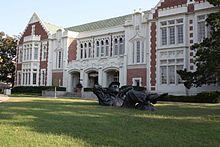
Several private schools also serve the area:
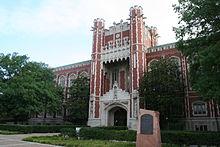
Norman is served by the Norman Public Library, which is part of the Pioneer Library System spanning many of the suburbs of Oklahoma City. The library has an inter-library agreement with the Metropolitan Library System of Oklahoma City. This allows patrons of the Norman Public Library to check out books from any library in the Pioneer Library System or in the Metropolitan Library System. Books can be reserved and shipped to a local library free of charge. In addition to books, the library maintains a collection of periodicals, videos, audio books, and research materials.
The Bizzell Memorial Library at the University of Oklahoma is the largest library in the state of Oklahoma, containing more than five million volumes. In addition to books, the library maintains over 17,000 feet (5,200 m) in length of manuscripts and archives, 1.6 million photographs, and more than 1.5 million maps. The library also houses more than 50 books printed before the year 1500.
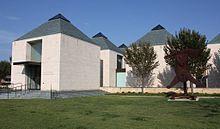
Norman enjoys many cultural attractions that are funded by the university. The Fred Jones Jr. Museum of Art made national and international news in 2000 when it was given the Weitzenhoffer Collection, the largest collection of French Impressionist art ever given to an American university. The collection includes works by Mary Cassatt, Claude Monet, Vincent van Gogh, Paul Gauguin, Pierre-Auguste Renoir, and Camille Pissarro.
The Sam Noble Oklahoma Museum of Natural History is a museum containing over 50,000 square feet (5,000 m2) of exhibits ranging from archaeology, paleontology, ethnology, herpetology, ornithology, and Native American studies. Its exhibits are intended to immerse visitors in the state aos long history. The museum features many complete collections of dinosaur fossils and is also noted for its Paleozoic collection, considered to be one of the largest and most important in existence.
The Moore-Lindsay House is a Queen Anne-style home built prior to 1900 by prominent Norman home builder William Moore; it was purchased by the city of Norman in 1973 and today serves as the city and Cleveland County's historical museum. Located at 508 N. Peters, the Moore-Lindsay House's architecture is representative of Norman during the Victorian era. The Cleveland County Historical Society maintains a collection of over 5,000 rare books, documents, and other artifacts in its archives located inside the house.
Catlett Music Center at the University of Oklahoma features many orchestral and jazz performances and the Weitzenhoffer Family College of Fine Arts' Schools of Dance, Drama, and Musical Theatre offer many student programs throughout the year.
The city is also home to many privately funded galleries and performance sites.
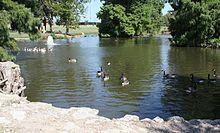
Norman aos Parks and Recreation Department facilitates 55 neighborhood and community parks, three recreation centers, a golf course and driving range, three disc golf courses, a complete swim complex with waterslides, a wading pool, 32 tennis courts, and three special services centers (that offer cultural arts and senior citizen activities). Griffin Community Park Sports Complex includes 16 soccer fields, 14 baseball/softball fields, and four football fields.
The Norman Transcript is the most widely circulated Norman-based newspaper in the city. It is a daily newspaper covering events in Cleveland and McClain counties. It is the oldest continuous business in Norman and was founded shortly after the Land Run of April 1889 on July 13, 1889.
The Oklahoma Daily is a student-run newspaper at the University of Oklahoma. It was first published in 1897, several years after the university aos founding. The paper has received numerous awards for journalism excellence including the Associated Collegiate Press ao Pacemaker Award.
KGOU is a full-service public radio station licensed to the University of Oklahoma. The station serves Norman and the greater Oklahoma City metropolitan area with a news/talk/jazz format, using programs from National Public Radio, Public Radio International, and others.[100]
Norman TV is a government-access television station airing on Cox Communications cable television channel 20. It broadcasts programming provided by the City of Norman, including video from city council meetings.[101]
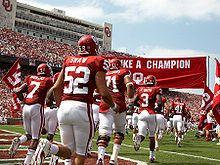
The University of Oklahoma sponsors many collegiate sporting events in Norman. The school is well known for its football program, having won seven NCAA Division I National Football Championships. In addition, it has the best winning percentage of any Division I FBS team since the introduction of the AP Poll in 1936[102] and has played in four BCS national championship games since 1998.[103][104]
During football season, the Oklahoma Sooners football program contributes significantly to Norman aos economy. During game day weekends, Norman sees an influx out of town traffic from all over the country. Norman aos local businesses, especially areas around campus and Campus Corner, benefit greatly from the game day traffic alone. The program ranks in the top 10 of ESPN aos top college football money-makers with home games generating revenues at approximately $59 million and game day operating expenses at about $6.1 million. [105]
In 1951 and 1994 its baseball team won the NCAA national championship,[106] and the women's softball team won the national championship in 2000.[107] The gymnastics teams have won four national championships since 2001.[108]
Other university men's sports include: basketball, cross country, golf, gymnastics, tennis, track and field, and wrestling.[109] Women's sports include: basketball, cross country, golf, gymnastics, rowing, soccer, softball, tennis, track and field, and volleyball.[109]
Norman hosts many free festivals and community events that occur throughout the year.
Medieval Fair is a celebration of medieval-themed games, art, and culture. The event is held during the last weekend of March in Reaves Park. It has been held annually in Norman since 1976 and was originally a forum for the English Department at the University of Oklahoma.[110] Today it is the largest weekend event held in the state of Oklahoma, with over 325,000 people in attendance in 2006.[111] Events Media Network has named Medieval Fair one of the top 100 events in the United States.
Norman Music Festival is an annual weekend music festival held in April in downtown Norman. Established in 2008, the event had over 26,000 people in attendance during the 2009 festival.[112] Originally a one-day event, the festival has quickly grown so large that it is now an all-weekend concert series. The festival highlights both local musicians and internationally acclaimed artists and features many forms and styles of music.[113]
Groovefest is a music festival held semi-annually at Andrews Park. Each Spring and Fall the music festival is held to help raise awareness about human rights. The event was established in 1986 by the University of Oklahoma chapter of Amnesty International.[114]
Jazz in June is a music festival held the last full weekend in June at various venues across Norman. The festival features both jazz and blues musical performances as well as jazz educational clinics taught by professional musicians appearing in the festival and post-concert jam sessions at local venues which bring headliners and local artists together.[115] Jazz in June, one of the major cultural events in the state as well as the City of Norman, attracts a combined concert audience of 50,000 drawn from throughout the state, region and nation. Another 100,000 or more enjoy these same performances through post-festival broadcasts on KGOU Public Radio as well as other public radio stations throughout the state, region and nation.
May Fair is an arts festival held every year during the first weekend in May at Andrews Park. It features top area performers, fine art, crafts, and food.[116]
Summer Breeze Concert Series is a series of concerts held from Spring to Fall at various park venues across Norman. The series is sponsored by the Performing Arts Studio.[117]
Midsummer Nights' Fair is a nighttime arts festival held during two evenings in June. The fair features art, music, and food and is held outside the Firehouse Art Center located in Lions Park.[118]
The Norman Mardi Gras parade is a celebration of Mardi Gras occurring on the Saturday closest to Fat Tuesday. The parade is held in downtown Norman and features themed costumes and floats.[119]
The Main Street Christmas Holiday Parade is a celebration of Christmas and the holiday season held every December in downtown Norman. The parade features holiday-themed costumes and floats.[120]

Norman Regional Health System is a multi-campus system that provides medical services in Norman and throughout south central Oklahoma.[121] Its Porter Avenue campus, located north of downtown Norman, is a 337-bed general hospital providing a wide range of services including acute care.[121] In October 2009, the Norman Regional HealthPlex campus opened in west Norman.[122] It provides a 152-bed state-of-the-art facility specializing in cardiology, cardiovascular services, as well as women's and children's services.[122][123]
Scheduled air transport, or major commercial air transportation, is available at Will Rogers World Airport in Oklahoma City, located approximately 20 miles (30 km) north of Norman. The airport serves approximately 3.38 million passengers per year.[124]
Norman is served locally by Max Westheimer Airport, a general aviation airport run by the University of Oklahoma.[125] The airport is one of only two airports in the Oklahoma City metropolitan area designated as a reliever airport to Will Rogers World Airport. Max Westheimer Airport is capable of handling aircraft up through and including executive class jet aircraft.[126]
The Cleveland Area Rapid Transit, operated by the University of Oklahoma, provides bus service throughout the 191-square-mile (490 km2) Norman area.[127] CART also provides service to the Social Security Administration offices in Moore, OK, as well as to Oklahoma City's Metro Transit hub in downtown Oklahoma City.[127] Metro Transit maintains a fleet of buses and trolleys serving the greater Oklahoma City area, including Will Rogers World Airport.[128]
In 2008, CART became the 39th public transportation system in the United States to be featured on Google Transit,[129] a website that allows transportation users to electronically plan their travel routes.[130] In 2010, CART buses were modified to include a GPS tracking system that allows riders to see the location of buses and their predicted arrival times via the CART and Google websites.[131] CART buses transport more than 1.3 million travelers annually.[127]

Inter-city passenger train service is available via Amtrak at Norman's Depot. Amtrak's Heartland Flyer provides daily round trip service to downtown Oklahoma City and Fort Worth, Texas.
Although Norman currently has no light rail or commuter rail service, there is growing interest in incorporating such services into the city's future transportation plans.[132]
The predominant form of transportation in Norman is roads and highways with 80.0% of all residents driving alone to work, 9.0% carpooling, and just 1.3% taking public transportation.[133] As of 2007, Interstate 35 alone was handling over 99,000 vehicles per day.[134] Other major highways include State Highway 9, a portion of which serves 28,000 vehicles per day, and U.S. Highway 77, which serves more than 25,000 vehicles per day.[135] The busiest roads in Norman are Berry Road (29,700 vehicles per day), 12th Avenue Northwest (28,000 vehicles per day), and Alameda Street (26,400 vehicles per day).[136]
Norman is served by two major federal highways:[135]
Norman is served by two major Oklahoma state highways:[135]
Electric utility companies servicing Norman include Oklahoma Gas & Electric, which is headquartered in Oklahoma City, and Oklahoma Electric Cooperative (a utility cooperative).[137] Natural gas is provided by Oklahoma Natural Gas.[137] The city of Norman offers water, garbage pickup, and recycling service through its Utilities Department.[137][138] Telephone networks, broadband internet, and cable television service are available from several companies including Cox Communications.[137]
In a study published in 2007, the National Institutes of Health deemed hexavalent chromium VI (chromium-6) to be a likely carcinogen in lab animals when consumed in large quantities in drinking water.[139][140] Prior to the NIH study, a World Health Organization study found that chromium-6 was a likely cause of lung cancer when inhaled by humans.[141] In 2010, test results released from a California non-profit group known as the Environmental Working Group showed that Norman's tap water has a chromium-6 concentration level of 12.90 parts per billion (ppb), which was the highest level detected among 35 US cities sampled in the study.[142] The group is studying chromium-6 levels in water supplies in an attempt to prove a causal link between the element's ingestion and cancer in humans, and as a result improve the country's water standards.[143]
The United States Environmental Protection Agency does not currently require testing for or set limits on chromium-6 levels in American cities' water supplies (but it does require total chromium-3 and chromium-6 levels not exceed 100 ppb[144]). The EPA has recently completed studies of the element on lab animals and is expected to make a determination on chromium-6 maximum allowed levels in June 2012.[145][146][147] The official total chromium-3/chromium-6 level present in Norman's drinking water has ranged from 20 to 80 ppb.[144] It has been proposed that the source of the chromium-6 is the Garber-Wellington Aquifer, which is known to have elevated levels of heavy metals.[144]
The issue of chromium-6 levels gained national attention with the 2000 film release of Erin Brockovich, which detailed a California woman's legal fight against Pacific Gas and Electric Company for allegedly contaminating her hometown with excessive levels of the element.[148]
In the past the Norman water supply has also been criticized for the presence of excessive levels of arsenic.[149] The city is attempting to combat this problem by building new wells and removing older ones.[150]
Word Count: 6108






